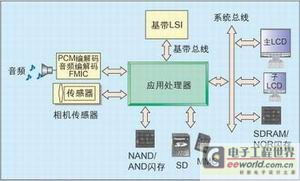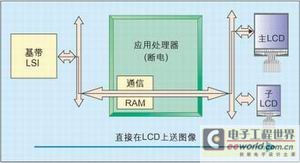In the next generation of multi-function phones, applications such as DSC, MP3, games and video are all in full bloom. If these functions are implemented only with the baseband chip, the CPU load will be significantly increased and the communication processing performance will be affected. The application processor (AP) is suitable for extending mobile phone functions, and the AP subsystem with modular architecture can be reused in mobile phones of different mobile system standards. This article will explore the requirements for APs and the integration of APs with existing baseband chips. This article refers to the address: http:// AP subsystem requirements 1. A simple AP must be easily connected to the baseband processor. The easiest way to connect is to use an SRAM interface. It has the flexibility to connect to 8-bit and 16-bit bus baseband systems. In addition, it needs to be compatible with the 8086 and 68000 system buses. The SRAM interface bus is isolated from the AP system bus so that the baseband access AP bus and the AP access system bus can operate simultaneously.
Rotary Switch Food Blenders by turning the knob to control blenders. Usually Rotary Switch Food Blenders have 2 or 4 speeds with pulse. And safety lock is optional.
Discription of Rotary Switch Food Blenders
Size: 1.0L,1.25L, 1.5L, 1.6L
Housing: ABS, PP, Stainless steel
Speed: 2 or 4 speeds with pulse
Rotary Switch Food Blenders Rotary Switch Food Blenders,Juicer Blender,Baby Food Blender,High Speed Stand Blender Flying Electronic Co., Ltd , http://www.flyingelectronic.com
Most cell phone manufacturers use a reference design from a semiconductor supplier. This solution consists mainly of object code and a small amount of source code. It is difficult for R&D engineers to modify and add new features to the program. In addition, the limited resources of the baseband chip make it impossible to implement high-load multimedia applications such as DSC, MP3, MPEG-4, gaming and video telephony, which are necessary for high-end mobile phones.
These manufacturers are experienced in the hardware and software of the reference solution. The quality of the reference program has been validated and proven in commercial products. It's best to reuse it in subsequent products instead of re-developing everything. In order to upgrade existing handset designs to high-end phones, the application processor architecture is a shortcut for manufacturers. Existing baseband systems are reusable and connected to an AP subsystem. This subsystem is similar to a module that can be connected to a baseband system.
Modular Architecture The traditional approach to extending handset features is to write and execute new applications on baseband chips. This single-chip architecture requires engineers to upgrade baseband chips to get more CPU power. The circuit is redesigned to achieve camera functionality and SD/MMC connectivity. The baseband code is ported to the new chip. Existing features are thoroughly revalidated even if they have been tested before. In addition, the program code size will be very large and complex for this single-chip architecture. This leads to longer development and debugging time and ultimately increases the cost of development.
By adopting a modular AP architecture, multimedia function applications that once occupied too much CPU resources can be executed on the AP. Most of the code and circuitry on existing phones can be reused with minor modifications. Software engineers can therefore focus on developing new applications. These applications only need to be developed and debugged on the AP.
This dual-processor approach separates baseband work from AP work, with one processor implementing basic telephony functions and another processor implementing multimedia functions. The baseband processor implements the basic telephony functions such as call/received by the current mobile phone, and the AP processor is dedicated to handling high-load multimedia applications. This eliminates the risk of baseband failure caused by software defects in new applications. For example, an unpaired enable/enable interrupt on a new application will suspend the real-time operating system schedule, which will terminate all telephony functions if it is executed on a single processor.
Communication between the baseband and the AP processor is achieved by messaging. Commands to activate or deactivate new applications are transferred from the baseband processor to the AP processor in the form of messages. 
In the form of a modular architecture, the AP forms a subsystem and is isolated from the baseband processor. The main LCD and sub LCD are connected to the AP instead of the baseband processor for optimal multimedia application visual performance. The audio encoder/decoder can be connected to the baseband or AP processor, depending on the difficulty involved. The video I/O hardware on the AP is dedicated to the camera sensor. It decodes the camera's output in YUV format and converts it to RGB for display. The SD/MMC card is connected to the AP to store data externally. On-chip NAND/AND flash can be used to store data and main programs in addition to the bootloader. NOR flash can also be used to store the main program and the boot loader, depending on the cost. SDRAM acts as a running memory. For multimedia applications that process image data, it should be large. The AP subsystem is shown in Figure 1. 
2. The "pass through" feature is due to the LCD being connected to the AP rather than the baseband processor, so extracting the image from the baseband to the LCD becomes an indirect action. The traditional fetching method requires two steps: the first step is to send a fetch command from the baseband to the AP; the second step is to send image data from the AP to the LCD. In this way, the AP is in a powered state, thus increasing power consumption. And the existing baseband code is modified from the direct access command. Engineers need time to develop, test and correct errors.
The "pass through" feature on the AP processor allows the baseband processor to access the LCD even when the AP is in power save mode (see Figure 2). In this mode, both the main LCD and the sub LCD are accessible. The maximum number of devices that can be "passed through" is set to four. This leaves room for future expansion. Power consumption is at a minimum in the power-saving state. Therefore, the standby time of the mobile phone can be maximized. With this direct access feature, existing code can be reused without modification. It reduces the workload of engineers and reduces development time.
3. Baseband Boot Function Normally, NOR flash memory is used to store AP programs. It can be removed when the AP provides the function of receiving the boot code, that is, the AP receives the boot code (boot loader) from the baseband processor, and then runs the code. By taking advantage of this feature, the main program can be stored on inexpensive NAND/AND flash memory. The bootloader loads the main program from the data flash to the SDRAM and eventually runs it on the SDRAM. A different boot loader can be used to rewrite/update the main program. Even if an abnormal interruption occurs during rewriting, there is no damage to the final product. This is because the rewrite boot loader is stored on the baseband instead of the AP's flash memory.
4. Video I/O
The video interface hardware on the AP is dedicated to decoding the output signal of the camera sensor. It detects horizontal and vertical signals from the sensor without writing code and decodes it into rows and columns. Converting YUV to RGB or converting RGB to YUV is done in hardware, not by software. This brings speed and efficiency. The output YUV format of an SXGA resolution camera sensor is 4:2:2, 15 frames per second, which means that 1,280 x 1,024 x 8 x 15 = 157, 286, 400 bytes per second can be processed. If calculated by software, this will consume a lot of CPU resources. 
5. Integrated baseband and AP
The integration of the baseband system and the AP subsystem is similar to adding an SRAM to the baseband processor. The baseband should retain up to 7 I/O ports and one interrupt to control the AP. Removing certain AP features, such as "baseband boot" and "pass through", can reduce the need for I/O.
This article summarizes the various applications on mobile phones that will increase the complexity. It is difficult, if not impossible, to have these applications implemented entirely by baseband processors. The application processor architecture simplifies the work of engineers who can extend existing handset designs to next-generation multimedia phones. This modular architecture minimizes modifications to existing handset designs, allowing engineers to focus on developing new applications. It also allows engineers to develop and debug applications on baseband and AP separately, significantly reducing development time. By employing different basebands, the architecture allows handset manufacturers to reuse hardware and software on the AP subsystem for different mobile systems. 